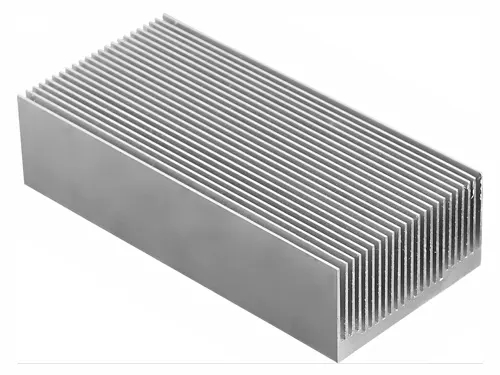- Product Details
Heat sink is an essential structural component in thermal design, generally have good thermal conductivity and large heat dissipation area, can provide a lower thermal conductivity thermal resistance, while providing a lower convective thermal resistance, with the use of reasonable cooperation with the fan can achieve better heat dissipation effect. Heat sinks are generally made of aluminum or copper. The use of aluminum to make heat sinks because of the relatively low price of aluminum, and has a better thermal conductivity; copper is used to make heat sinks because of the excellent thermal conductivity of copper, can play a significant cooling effect. The following will be introduced from the material side of the heat sink.

Ⅰ)Aluminum heat sink
Aluminum heat sink commonly used material for AL6063-T5, aluminum is the best heat dissipation effect of metal materials other than copper, light weight, good corrosion resistance, cheap, good thermal conductivity, widely used in electronic appliances, engineering machinery industry, wind power generation, photovoltaic energy storage, aerospace and other industries. When the design of the aluminum heat sink for electronic heat dissipation is not ideal, there are several options to achieve the desired results. 1. increase the density of the leaf teeth, thereby increasing the surface area of the heat sink to achieve better heat dissipation; 2. design the leaf teeth into a wave shape to increase the heat dissipation area.
Ⅱ)Copper heat sink
Copper heat sink commonly used material for red copper C1100, copper’s high thermal conductivity, the production of heat sink heat dissipation effect is very obvious. The density of copper is too heavy, resulting in copper heat sink weight is much higher than aluminum heat sinks, so copper is not suitable for making large heat sinks, mostly used for small electronic products. Copper heat sink common production process for shovel teeth, forging, brazing, etc.
Ⅲ)Aluminum-copper composite heat sink
Aluminum-copper composite heat sink refers to the use of copper and aluminum two materials to produce a heat sink, the production of the heat sink both aluminum heat sink lightweight, but also copper heat sink high thermal conductivity, which is a more popular heat sink processing process today. Copper and aluminum composite heat sink processing methods such as riveting, welding. Welding refers to the use of copper and aluminum heat sinks of two materials through friction welding into a composite heat sink, can also be used to produce composite heat sink brazing, which is also quite mature processing technology.
Riveting refers to the riveting of copper tubes on the aluminum base plate to make them into a heat sink. This production process is mature and stable, and is one of the most commonly used processes in the heat sink industry. The aluminum base plate requires a special extrusion die or a common aluminum plate on the market, and the copper tube slot is processed by CNC, then the copper tube is flatly rolled into the base plate slot by a professional rolling machine, and the slot gap is filled with thermally conductive epoxy resin, and then CNC finishing is performed after the epoxy resin solidifies. After passing the test, a series of tests such as air tightness test, heat test, etc., and then full inspection of appearance, and then packaging and shipping to customers.
Ⅳ)Services And Capabilities Of Regis
1) Service
Regis technical team has 15 years of experience in radiator design and manufacturing, and has maintained market-leading technology through years of cooperation with world-renowned companies. Can provide from thermal simulation, mechanical design optimization, production, testing and quality improvement, to customer after-sales service. At present, the company has more than 100 sets of processing equipment, and has more than 3,000 sets of various extrusion dies, cold forging dies, stamping dies and die-casting dies. Products are exported to more than 60 countries and regions around the world, serving more than 80 customers around the world.
2) Ability
1》 Design Services
- Computer Fluid Dynamics (CFD) helps radiator research and development, reducing research and development costs and time
- Computer-aided design (CAD) provides guarantee for radiator structure design
- Passive Solutions for Increased Reliability
- Estimated cost of the product
- Reduce volume and weight
2》Sample design and reliability testing
- CMMs and precision measuring tools
- Thermal Resistance Test Equipment
- Hot Chamber Shock Testing and Cycling
- Salt Spray Testing for Corrosion Analysis
3》Manufacturing Capability
- State-of-the-art CNC machinery
- Strict quality management
- The latest production technology
- Focus on continuous improvement
- Sturdy packaging design